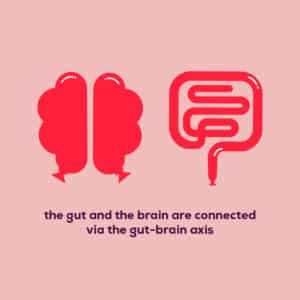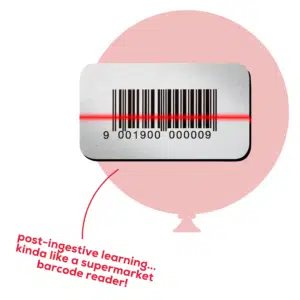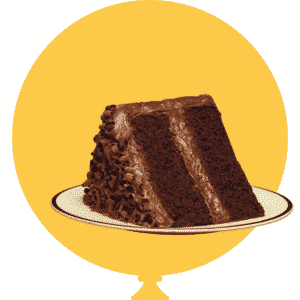the gut and cravings
Have you found yourself at the fridge one too many times over this unplanned lockdown season?! Well, what if we told you your gut could be dictating what you want to eat? Well, partly anyways!
We’ve asked Elouise Rice, a dietetic student at Queen Margaret University, to give us the low down:
The gut-brain axis
There is a communication system between your gut and brain which is referred to as the gut-brain axis. This connection is bi-directional, meaning the gut can communicate with the brain and vice versa (1). They are connected both physically and biochemically. The gut is often referred to as the “second brain” as it has such an influence over our brain (2).
A classic example of this communication pathway is having ‘butterflies’ in your stomach when we are feeling anxious or nervous. The gut-brain axis has also been linked to many diseases and disorders such as obesity (3), Irritable Bowel Syndrome (4), depression and anxiety (5).


How does it all work?
There are approximately 500 million neurons in your gut (impressive, right?), which are all connected to the brain (6). However, there is one nerve that is the star of the show…the vagus nerve. Research has shown that the vagus nerve may be responsible for the phenomenon known as post-ingestive learning.
What does this mean? This is where the digestive system analyses the food you have ingested and evaluates the food in terms of nutritional value, as well as deciding the amount that should be eaten and how we should react to that food when we ingest it again. Think of it like a barcode reader in a supermarket.
The vagus nerve sends these post-ingestive signals on up to the brain to the ventral tegmental area (VTA). Here we can find a concentration of dopamine, known by his street name, the ‘pleasure’ or ‘motivator’ neurotransmitter. Dopamine is a neurotransmitter thought to be involved in our reward circuit. It reinforces behaviours that satisfy our basic needs including reproducing, responding to aggression and eating that calorific bit of chocolate cake in the fridge…(7). If your gut microbiome is disrupted, it can inhibit the cells that make dopamine.
This may explain why we are visiting the fridge that little bit more often right now, as we are bored and are driven to do things that activate this reward circuit (ie. eat nutrient-dense, calorie-dense food!).

So where is the evidence for all this?
It all stems from mice. The experiment we are looking at involved injecting food directly into the stomachs of the mice, meaning the taste buds were bypassed and thus the taste of the food didn’t matter. The mice had an option of 2 levers which released different food directly into their stomach; the high-calorie sugar or low-calorie sweetener. The high-calorie lever was chosen significantly more. This reflects the mechanism of post-ingestive learning, where your gut detects the nutritional value of what we are consuming.
The same experiment was repeated, but this time the vagus nerve was cut. This time, the post-ingestive learning wasn’t seen – so the reward centre wasn’t being stimulated and the high calorie lever wasn’t favoured.
What do we know now?
Calorie-dense / nutrient dense foods trigger the release of dopamine – this activates the reward centre in our brains and so the behaviour is reinforced – so you kept going back for more – like that family sharing size chocolate bar you just can’t put down!
As we can see, it is very possible that our gut influences our food choices through the gut-brain axis, specifically the vague nerve.
More research definitely needs to be done, as much of the evidence is based on mice only.
Try exploring your feelings around cravings and whether activating that reward centre through another activity could give you what you need.
References
- Marilia Carabotti, C. (2015) “The gut-brain axis: interactions between enteric microbiota, central and enteric nervous systems”, Annals of Gastroenterology : Quarterly Publication of the Hellenic Society of Gastroenterology, 28(2), p. 203. Available at: https://www.ncbi.nlm.nih.gov/pmc/articles/PMC4367209/ (Accessed: 29 June 2020).
- Foster, J. (2013) “Gut Feelings: Bacteria and the Brain”, Cerebrum: the Dana Forum on Brain Science, 2013, p. Available at: https://www.ncbi.nlm.nih.gov/pmc/articles/PMC3788166/ (Accessed: 29 June 2020).
- Niccolai, E. et al. (2019) “The Gut–Brain Axis in the Neuropsychological Disease Model of Obesity: A Classical Movie Revised by the Emerging Director “Microbiome””, Nutrients, 11(1), p. 156. doi: 10.3390/nu11010156.
- Irritable bowel syndrome: A microbiome-gut-brain axis disorder?”, World Journal of Gastroenterology, 20(39), p. 14105. doi: 10.3748/wjg.v20.i39.14105.
- Liu, L. and Zhu, G. (2018) “Gut–Brain Axis and Mood Disorder”, Frontiers in Psychiatry, 9. doi: 10.3389/fpsyt.2018.00223.
- Mayer, E. (2011) “Gut feelings: the emerging biology of gut–brain communication”, Nature Reviews Neuroscience, 12(8), pp. 453-466. doi: 10.1038/nrn3071.
- A major organ plays an unprecedented role in choosing what you eat (2020). Available at: https://www.inverse.com/mind-body/gut-brain-axis-controls-food-choice (Accessed: 29 June 2020).